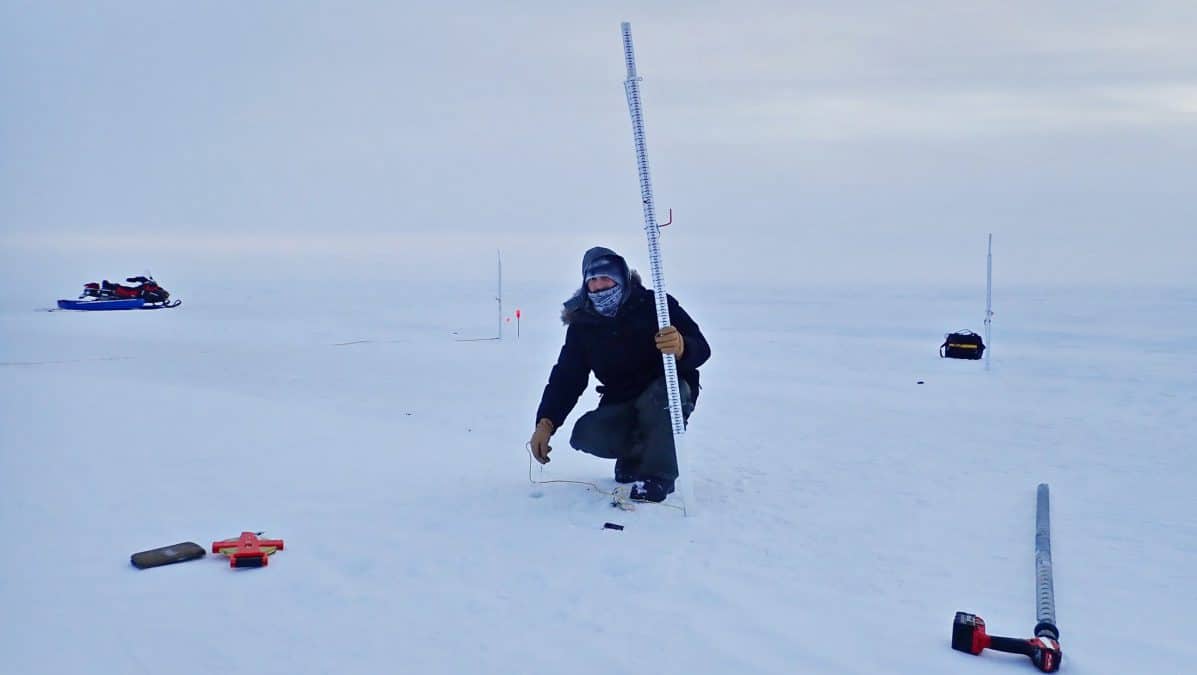Born and raised in North Carolina, Citizen Potawatomi Nation member Jacob Pratt decided to attend the University of Alaska Fairbanks to obtain his master’s degree in geophysics before visiting the campus or the state.
“I ended up packing everything I owned into my truck,” and spent two weeks driving across the United States and through Canada, he said.
He studied geology at Appalachian State University in North Carolina after serving in the Marine Corps and living in Japan for three years. While working on his bachelor’s degree, Pratt focused his research on glacial sediment in Alaska.

“It was the … biggest challenge I had in undergrad, and so if I was going to do something at that next level, I wanted it to be something that I already felt challenged in at the level I was currently working,” he said. “And so, I just wanted to see what the craziest, harshest conditions, toughest coursework — what’s it got to offer?”
That desire led him to studying something called bottomfast sea ice in Utqiagvik, the northern most city in the United States, located in the Alaskan Arctic. Bottomfast ice can grow up to 8 feet thick during the winter, and in shallow areas near the coast, the entire water column can freeze. It gains stabilization when the ice sheet freezes to the floor and anchors in place.
“Sea ice is a valuable resource for coastal communities along the Beaufort Sea, especially,” including transportation, Pratt said.
Scientists take as many ecological and environmental measurements as possible to find trends affecting local fish populations and benthic (deep sea) communities.
“A lot of these things are big concerns for the food population, food availability up there, because subsistence hunting is still a large part of the Native communities’ everyday life,” he said.
As part of a 10-year study looking at changes in the local ecosystems, Pratt and other scientists frequently talk with the Indigenous populations. His advisor views their insight into the area as an invaluable resource.
“We like to sit down with the elders and ask them, ‘What have you seen going on with the ice?’ or ‘Can you describe this weird process that we’re seeing with the ice?’ And sometimes, they have ideas that I wouldn’t have even known to think of. It’s due to thousands of years’ experience around the ice, and their knowledge is endless,” Pratt said.
Working with the Inuit peoples made the Greemore descendant eager to learn more about his Potawatomi ancestry from his maternal grandfather. While he has spent some time in Oklahoma, he hopes to attend the Family Reunion Festival and visit more in the future.
Running out of time
Based on current climate models, Pratt estimates sea ice in the arctic will see ice-free summers by 2035 due to rising global temperatures. That leaves less than two decades to study bottomfast ice, if trends continue. With advances in remote sensing data, he is working on new methods to identify bottomfast sea ice using interferometry.
“What I’m using now is a method that’s looks at microscale motion at the surface level to determine whether or not the ice is stable — bottomfast ice — or whether it still has a dynamic component to it, which would mean that there’s water flowing underneath it or it’s susceptible to motion by wind or changes the in-ocean current,” Pratt said.
While remote sensing data is a valuable tool, there still needs to be a ground component to verify lab results. Part of his work includes developing easier and faster methods for collecting the information, particularly ones more accessible to local populations. He started using his creation last winter. The pandemic prevented Pratt and other members of the research team from traveling back out into the field, and they lost their data. However, the importance of the work carries him forward.
“I will write a thesis detailing the interactions of bottomfast sea ice in Arctic lagoons and the surrounding ecosystem.” Pratt said. “And so it still needs to be fleshed out a little bit, but a lot of it comes from the ecosystem responses. These studies will help to understand which systems will be affected most as ice thickness and extent continue to decrease at an unprecedented rate.”
He gave a virtual presentation in December 2020 as part of the annual American Geophysical Union conference about his work mapping the locations of bottomfast sea ice and its importance. Always up for a challenge, Pratt hopes to get out into the field one or two more times before he graduates with his master’s.
Find the American Geophysical Union online at agu.org or on Facebook @AmericanGeophysicalUnion.
